|
The
2nd half of this story about the author's personal experience with
the Wright Brothers, "The
First Practical Flying Machine," was printed the April 1968
American Aircraft Modeler. Four Keys to the Sky
Discovering the secret of flight: Part 1
Douglas J. Ingells
All photos: Smithsonian Institution
THE tall, boney-cheeked, pallid man of about 35 years of age,
rose from his chair at the speakers' table and took his place at
the rostrum. His was to be the principal address of the evening
before the annual meeting of the Western Society of Engineers in
Chicago. The man's name was Wilbur Wright, an unknown bicycle manufacturer
from Dayton, Ohio. Many in the audience wondered why he had been
selected to address such a learned group.
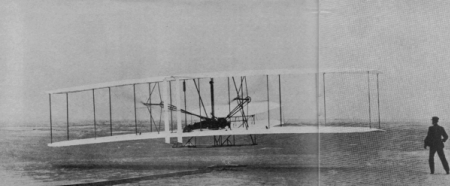
After the plane had been set upon the launching
track and the engine run up, Orville arranged the camera on a tripod
and focused it upon II point II few feet short of the end of the
track. Confident that the flight would be II success, he asked John
T. Daniels, one of several men from the Kill Devil, N. C. lifesaving
station who were present, to snap the shutter as the plane cleared
the starting rail. Daniels apparently did as he was told, but the
Wrights were not sure they had a picture until Orville developed
the film in their darkroom after they had returned to Dayton, Ohio.
Wilbur was visibly nervous as he stood there. In the first place,
he didn't like public speaking. Secondly, it was "Ladies Night"
and he was always shy around the fairer sex. And he felt very conspicuous
in his plain business suit. Almost everyone else was dressed in
formal attire.
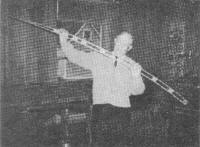
The author, in the bicycle shop where the plan was made,
examine a wing rib built by the Wrights.
|
He glanced around the room, and recognized some of the faces.
Alexander Graham Bell, inventor of the telephone was there. Another
personage was Dr. Samuel Pierpont Langley, secretary of the great
National Smithsonian Institution in Washington, D. C. So was Professor
John J. Montgomery of Santa Clara College, Calif. And there was
Octave Chanute, the president of the society who had invited him
to make this speech.
Chanute, Montgomery, Langley, Bell, these men of science and
invention, Wilbur recognized because there was a common interest
among them which he, too, could share. Chanute was famous for his
gliding experiments, a foremost authority on the science of aeronautics
in this country, author of the book, Progress In Flying Machines.
Montgomery, likewise, had made great strides in gliding on the West
Coast, creating quite a furor among flight enthusiasts with his
curved wing surfaces and experiments with hinged ailerons. Langley,
already had flown his large steam-powered model aerodrome to prove
the practicability of mechanical flight. And Bell, whom everyone
believed the performer of miracles after his invention of the "talking
wire," had just announced he was building a man-carrying flying
machine. The common bond among these men was that they were pioneers
in the exploration of the principles of flight.
Wilbur could share that distinction because he and his brother
Orville, for the past two years had been doing their own experiments
with gliders. Indeed, they had recorded more time in the air gliding
at Kitty Hawk, N. C. than any other individuals. And Chanute had
seen them perform. That is why he had invited Wilbur to talk about
the Wright Brothers' progress with their flying machines.
The speech Wilbur gave was anything but dull. His nervousness
disappeared when he began to expound his theories. His words had
the ring of authority and fact, not fiction. The talk lasted for
about 35 minutes, but during that time there were many raised eyebrows,
the shaking of heads in disbelief, whisperings of criticism about
his text, among the staid members of the Society who were generally
recognized - and considered themselves - the foremost authorities
on the science of aeronautics in this country. They were not too
pleased with what they heard. Wilbur had challenged some of their
theories. In fact, he said that some of their published data on
the subject were just plain wrong!
"Who is he to doubt our facts?" Alexander Bell is said to have
remarked. And Chanute, himself, confided to Wilbur after the speech,
"You may have made some enemies in some highly influential places."
Whether he did or did not, Wilbur Wright that evening made history
of a sort. It was a night to remember in the annals of aviation,
although few histories of the air put much emphasis on the importance
of his speech. Few know of it.
The date was September 18, 1901. And the significance is that
if Wilbur had not made that speech, the Wright Brothers might well
have discontinued their experiments. Admittedly, that might have
changed a lot of things.
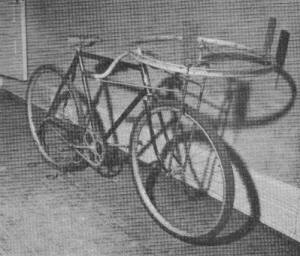
Lacking a suitable tunnel, the Wrights used this bike to
check out airfoil sections. Two may be seen mounted on the
tireless wheel which altered angles.
|
The magic wind box: Years later when I was a young cub reporter
on the Dayton Daily NewB, the Wrights' hometown newspaper, I was
talking with Orville Wright, and he brought up the subject of that
speech Wilbur made in Chicago. Orville was 65 then, the surviving
brother (Wilbur had died of typhoid fever, May 30, 1912) and he
was in good health, alert, and with a keen memory. Contrary to many
reports, he liked to talk, even to reporters, provided he could
talk about their early experiments and "clear up all those mistakes
you fellows write." The big problem was getting in to see him. Fortunately,
we lived only a few doors from his laboratory on North Broadway,
an unpretentious building just around the corner from the site of
the original shop where they built the first airplane.
My father had introduced me to him one day when I was only about
18, and I'm sure he saw more hero-worship in my eyes than reportorial
inquisitiveness, so I never had much trouble getting to talk to
him. Most of the time I'd catch him early in the morning when he
drove up in his old Plymouth coupe, and then he'd invite me into
his office. The truth is, I don't believe I ever asked him ten point-blank
questions in the many, many times I had opportunity to be with him.
We'd just talk, which is the way it was that day when he brought
Wilbur's speech into the conversation.
"It was an important turning point in our thinking," he explained.
"I guess we were a little scared that we'd bitten off more than
we could chew in making some of the claims Wilbur had discussed
publicly. It was a matter of honor that we had to prove that we
were right in our own theories. I think this was a very great influence
in our decision to keep on with our experiments. We thought we were
being presumptuous about our own data in contradicting some of the
supposedly established facts of the more learned experimenters."
He went on to clarify this position, admitting that to date their
information was based on actual gliding experiments in 1900 and
early 1901 at Kitty Hawk. There, they achieved remarkable success
with their glides, but as Orville put it, "our progress was mostly,
trial and error method, and we learned to our surprise that some
of the data on air pressures and lift (probably Lilienthal's) which
had dictated our wing shapes or curvature, seemed to be in error.
The trouble was, no set of figures we got relative to lift! drag
ratios was like the next one, because of changing winds and other
atmosphere conditions, and there was no yardstick to go by. We certainly
weren't absolutely sure about any of our data ... "
Because there was this doubt, after Wilbur's speech, they took
a more scientific approach to the problems, and the
world benefited. "It was really a matter of simple economics,"
Orville once confided. "We didn't have the money or time to go on
building different shapes of wings, more and more gliders, hauling
them to Kitty Hawk and running more and more experiments in the
air to arrive at some basic, reliable design criteria. So, we decided
to find a way to get this data by another method."
A first attempt was most ingenious.
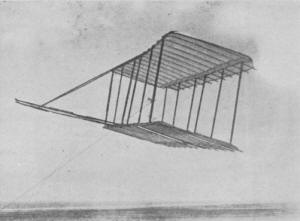
The 1900 glider was flown as a kite. Wing section appears
to be almost flat.
|
They had the principle of a wind tunnel in mind only in reverse.
Orville told me, "We made a series of small airfoil sections of
different curvatures and mounted them on the handle bars of a bicycle.
Then, we raced the bike into the wind, observing the changing angular
tilt, up or down, of the various shapes in the air stream. In this
way we definitely established some shapes indicated greater lift
potential than others. But there was still the problem of maintaining
a constant flow of air, setting up a basic table for comparisons,
and a measuring device."
In quest of a solution to the problem, Orville took an old rectangular
box about 18 inches long and a foot square at the ends, -and jerry-rigged
a crude wind tunnel. Inside he fashioned an apparatus, much like
the principle of a weather vane, to permit mounting different shaped
wing contours in an airstream forced through the open-ended box
by a fan. A glass top, permitted them to observe the changing angle
effects of the air current on the different surfaces, and a simple
ruler let them measure the differences. "We were encouraged," he
said, "when we began to get some constant figures from which to
work as a base in drawing comparisons, between curved surfaces and
plane surfaces."
As a result, they decided to build a larger wind tunnel. Orville
called it "our magic wind box" and you can see it today in the original
Wrights Bicycle Shop at the Henry Ford Greenfield Village museum
a few miles from Detroit. The birthplace of the airplane was moved
here to preserve it for posterity. The small wind tunnel, so far
as is known the first of its kind used by the early pioneers of
flight, is still operable.
The Wrights original wind box is an open-ended wooden box about
six feet long and 16 inches square. At one end is a fan driven by
a small one-cylinder gasoline motor which they also built themselves.
Inside the box near the fan is a pigeonhole partition (like honeycomb)
devised to straighten out the airflow affording more accurate measurements
of the air pressures as the wind whistled around the various wing
shapes suspended in the tunnel at different angles to the airstream.
In principle, the whole idea was like holding your hand out the
window of a speeding car and changing the angle of the flat surface
as the rushing air strikes it. Instead of feeling the difference
in air pressures, the W rig h t s measured it with a homemade balancing
scale.
I remember, right after the end of World War II, his secretary,
Mabel Beck, called and said Orville had found something behind some
old filing cabinets that might be of interest, and to come over
and have a look. When I got there, he was all excited about his
discovery: some rusty old broken pieces of a hacksaw blade and bent
bicycle spokes! "These are part of the measuring scale we used to
measure the air pressures in the first wind tunnel," he explained.
"It was the first device that enabled us to get any kind of consistent
figures, measuring the variable air pressures."
Unimportant? Indeed, not. A hacksaw blade and a bicycle wheel
spoke helped them to pick the lock on the door of the vault holding
the sky's secret.
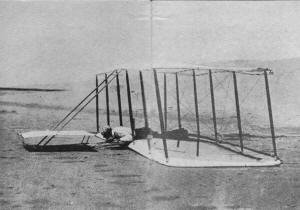
Wilbur in a prone position following a landing at Kitty
Hawk of the 1901 glider.
|
Altogether, in the wind box, they tested more than 200 different
wing shapes, thicknesses and configurations. Each one taught them
something. A thin wing, was more efficient than a thick wing. A
wing with a curved cross section was better than a flat wing. Such
data as these enabled them to formulate tables of air pressures
and their effects, which in turn showed them clearly the amount
of lift and the best configuration and wing arrangements by which
they could design a machine capable of lifting itself.
"It was at this point in our experiments," Orville once remarked,
"that we began to think seriously, not just of gliders, but of a
heavier-than-air, man-carrying vehicle of the air. The data we obtained
on the lift characteristics of the various airfoils, led us to believe
that a wing could be designed that would support the weight of a
powerplant and an operator. If the results had been negative, instead
of positive, I'm sure we would have concluded that human, mechanical
flight was impossible."
I'll never forget how Orville emphasized the importance of the
wind tunnel tests. One time, for instance, I asked him two rather
naive questions: "Did you have a lot of apprehension about whether
the first power-driven machine at Kitty Hawk would fly? Did you
get much sleep the night before that historic flight on December
17, 1903?"
"Oh, we slept all right," the first man to fly answered with
a chuckle. "We knew the machine would fly; all our tests in the
wind box indicated it would. We were really more concerned about
whether the engine would start and about the weather!"
Significantly, the huge and complex wind tunnels in use today
at various aeronautical research centers around the country, provide
little refinements in the basic data which the Wrights were able
to obtain in their original experiments, when tests are run on the
same airfoil sections the Wrights used. It has been tried and proven.
Generally recognized as inventors, who by trial and error managed
to achieve powered- flight ahead of their rivals, the Wrights seldom
are given credit for their long hours of tedious, grueling and monotonous
laboratory work as pioneers in basic aerodynamic research. They
didn't just invent the first successful power-driven, man-carrying
flying machine; they discovered the successful formulas for human
flight.
Beyond this, they applied them. One minute, they were scientists,
probing into the unknowns of the ocean of air above. The next minute,
they were mechanics molding the science they discovered into machinery.
The wing and the sail: The Wrights became interested in flying
machines when they were young boys. Their father, Milton Wright,
a United Brethren Bishop, one day brought them a small toy flying
machine. Made of bamboo, paper and cork, with a small rotor, powered
by a rubber band, the toy flew up to the ceiling and fluttered back
to the floor; the principle of the helicopter. It was the invention
of a Frenchman, Alphonse Penaud. Both Wilbur and Orville were intrigued
by the little toy and tried unsuccessfully to duplicate it with
larger models. It was their first thinking, Orville admitted, about
anything to do with flying machines.
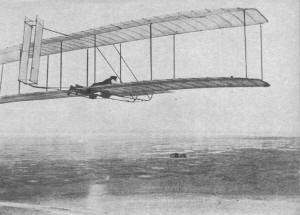
The 1902 glider sails off Kill Devil Hill, Kitty Hawk, on
October 21, 1903.
|
Recalling these childhood experiences with the Penaud toy helicopter,
Orville said: "It led us to go to the library and read up everything
we could on the subject of flying machines, whereas we probably
wouldn't have had this interest, if it weren't for the little toy."
In this quest for more knowledge they met, in the pages of magazines
and books, the great German glider enthusiast, Otto Lilienthal,
whom Orville said, "probably influenced us more than anybody else
to build our first glider."
"Not because we had the idea of conquering the air, or inventing
our own flying machine," he confided, "but chiefly because we thought
soaring through the air in a gliding machine must be a great sport."
By this time, it must be remembered, they had already established
themselves in the bicycle business, and both did a lot of bike racing,
a popular
sport just before the turn of the century. "The next thing to
flying," Orville described it, "because of the need to balance one's
self while going forward at terrific speeds."
In all their reading, the Wrights felt that Lilienthal, of all
the early flight pioneers, was closest to being on the right track.
After his death in 1896, they began building their own man-carrying
kites and gliders. Even in death Lilienthal greatly influenced their
thinking. The German was killed, they read, because he lost his
balance when a high gust of wind threw his machine out of control
and smashed it to the ground. This had great significance, they
thought.
"We decided to concentrate on a better system of control and
balance technique in our gliders," Orville declared. "It seemed
to us that there must be a better way to use the air itself as an
ally, rather than to conquer it as an enemy. For some reason, we
thought of applying the principle of the sail to the wing." They
did not know it then, but this was to be a vital key to their success.
The analogy of the sail and the wing was a good one. For by changing
the different surfaces of their gliders - presenting more area to
the rushing winds to accomplish bank and turn, climb and dive, and
directional stability - they were "sailors of the sky." More sail
here, more sail there; more wing here, more wing there - to effect
maneuverability. They reasoned, and rightly so it proved, that sailing
ships of the sea and ships of the sky reacted the same to variable
air currents and pressures.
In their early kite flying experiments, Orville explained that
they applied the principle of warping the wing tips to help in lateral
control. (This was the beginning of the present day aileron.) A
system of movable elevators - in the Wright gliders they were forward
of the wings - provided up and down control, allowing for climb
and dive. For directional control they later devised a movable rudder
surface.
Others had tried out these' ideas, independently or in pairs,
but the Wrights were the first to devise a system of control employing
all three movable surfaces - the aileron, elevator and rudder. They
were also first to link the aileron and the rudder together, providing
stability in the bank and turn. Later, this became the strong point
of their patent rights in numerous suits and court battles. On this
point, alone, they won the distinction of being called the "inventors
of the airplane."
Most of these experiments with the various control combinations
were carried out first on large kites and a biplane glider flown
as a kite from high elevations around Dayton. But in 1900-01 they
took their machine to Kitty Hawk, N. C, an isolated spot near Cape
Hatteras, on the Atlantic coastline where the U. S. Weather Bureau
had told them the winds should be excellent for gliding.
The first Kitty Hawk gliders: The Wrights went to Kitty Hawk
for the first time in September of 1900, set up camp near the U,
S, Coast Guard station there in the beach, and assembled their first
man-carrying glider. The machine had a wing span of about 17 feet,
an area of about 160 square feet and it weighed about 50 pounds.
Constructed of spruce frame, wire and glue, with wing surfaces covered
with sateen, it embodied two innovations which, so far as was known,
had never been tried: 1) There was a front rudder or elevator to
control pitch and yaw; 2) There was a unique truss arrangement for
warping the wing tips (the first attempt at the aileron) for lateral
balance, the machine had no empennage or tail of any kind, and there
was an uncovered frame section on the lower wing (it was a biplane
design) where the operator lay in a prone position - his feet manipulated
the wing warping mechanism!
Their first experiments with this machine were conducted gliding
down the slopes of a 100-foot-high sand dune called "Kill Devil
Hill," because the winds here were stronger and they soon had discovered
their machine needed the increased air pressures to accomplish desired
lift with a man aboard. Orville later recalled, "This was the first
indication we had that, perhaps, some of the tables on air pressures
(Lilienthal's and Chanute's which they had used as a guide in designing
the glider) were possibly in error. The machine required a much
stronger wind than the tables called for to lift its own weight
and that of the operator." .
In all, from September until near Christmas of 1900, they flew
the glider as a kite for about ten minutes and in free glides for
about two minutes. Both took turns riding the kite, or making the
free flight glides.
"It was much less time than we had hoped to have in the air,
because of the varying wind conditions," Orville explained. "But
even so the results were encouraging. The wing-warping at the tips
worked far better than we had hoped for in maintaining lateral balance.
The front elevator was highly satisfactory in its response to the
slightest movement, and gliding itself was most exhilarating ...
"
"What ever happened to that first glider?" I asked him.
It was one of his favorite stories. "We gave it to Bill Tate,
who operated the life-saving station, and I think he used the frame
for kindling," he said wryly. "And Mrs. Tate used the white satin
covering to make some dresses. She used to remind us that it was
much too fine a material to be used for such a contraption as a
flying machine!"
The irony is, the first glider belonged as a museum piece in
any collection depicting the progress of man's conquest of the air,
for on the strength of its performance, the Wrights decided to build
a larger machine and return the next year for more experiments.
They were back at Kill Devil Hill again the following summer
(June, July and August of 1901) with a larger machine. This Kitty
Hawk glider, of the same basic configuration as the first one, had
a wing span of 22 feet and weighed about 100 pounds, the largest
machine that anyone had so far attempted to fly. About the only
visible difference, other than size, between the two gliders, the
first and second, was that the larger machine had an increased curvature
(camber) in the airfoil sections. The Wrights believed this would
give them the added lift they needed.
During this season's series of tests they broke all existing
records for gliding distances, and stayed aloft longer than any
of their predecessors. Although the machine did not have all the
stability and control of the first glider, they were satisfied that
their system of control could work on larger gliders. But they did
run into strange phenomenon. Using their wing warping technique
- presenting a steeper angle of wing surface to the wind on one
side than on the other (the angle of attack or angle of incidence,
in technical terminology) they found that instead of causing the
machine to rise, as they expected, it sometimes resulted, in dangerous
descent.
From this unexpected characteristic, they concluded that something
else was needed to control the equilibrium. They were also of the
opinion that a changing of the center of the air pressures on the
various surfaces was what caused the erratic behavior of their glider.
"We were almost convinced now," Orville declared, "that the accepted
tables on air pressures were unreliable, those of others and our
own included. We were certain there was needed a more scientific
approach to the problem, and we truthfully didn't know how to go
about it. At this point we seriously thought of giving up."
Wilbur was more positive. Returning from Kitty Hawk he made the
remark to Orville, "Man will never fly, not in a thousand years!"
Chanute who had witnessed their flights at Kitty Hawk in 1901,
gave them encouragement and urged them to continue. It was his greatest
contribution to aviation. He talked Wilbur into giving his famous
speech, and that, as we know, because of the various reactions which
the Wrights took as an affront to their integrity, resulted in their
making the wind tunnel experiments. And the wind tunnel results
were so encouraging that they decided to build another glider and
continue further experiments at Kitty Hawk in 1902.
The. Victory glider: Their wind tunnel experiments which lasted
about two months during the autumn of 1901, by Orville's own admission,
were a great turning point in their thinking. These tests were far
more exhaustive than most history books record. The Wrights own
papers, hand-written and meticulously kept, revealed that they had
tested biplane, monoplane and even triplane wing arrangements; they
tried staggering the wings and even putting one wing ahead of the
other in the same plane as in the Langley machines; they tried wings
of different thicknesses and chords. The test objects were small
sections, none more than about seven inches in span, and they were
made of metal, highly polished to provide undisturbed airflow over
the surfaces.
One of the most important results of these tests, according to
Orville, "was what we learned about the relationship of the span
to the width or chord, in wing profile." This (aspect ratio) they
learned was most efficient when the span was much greater in proportion
to the chord, a discovery contrary to some previous published data.
"The truth was," Orville pointed out, "we found so many discrepancies
in much of the previous published data that to satisfy our own curiosity
we decided to forget all about it, and design our next machine around
our own figures."
This they did, and in September of 1902 they were back at Kitty
Hawk for the third time with a machine which differed in several
respects from their previous design attempts. Orville called it
The Victory Glider because, "we were so sure of success based on
the wind tunnel data."
The new glider had a wing span ten feet longer than did the 1901
machine, but oddly it had very little more total wing area. On the
basis of their wind .tunnel tests they had changed the "aspect ratio"
making the span six times the chord instead of three as on the previous
machine. They had also added an empennage; two fixed vertical rudders
supported on boom sticks aft of the wings. A different method of
controlling the wing warping was also devised, a cradle-like arrangement
permitted the operator to change the wing tips by hip movements.
During September and October of 1902 with this machine they made
more than a thousand glides, in winds up to more than 35 miles an
hour and for distances of the length of two football fields. No
one had ever tried gliding in winds of such velocity before, and
this was considered a supreme test of their control techniques.
Moreover, on occasion, they found the glider "standing still and
soaring, emulating bird flight, without a tendency to descend,"
as Orville put it. Such performance had never before been accomplished
by other experimenters. In these moments, the sailplane was born,
and soaring as a sport, although the Wrights were too busy thinking
of other things to pay much attention.
They were having a strange control problem which caused minor
mishaps. Under certain conditions the machine would fall off on
one wing, and cartwheel, digging the wing tip into the sand. They
called it "well-digging," but it was really the first tailspin.
Try as they might, it seemed impossible to correct. Then, Orville
came up with the idea of making the twin rudders movable, so they
could counteract the movement. By doing
this, it was possible to direct air pressures onto the high wing,
augmenting the wing warping, and bring the machine level. The twin
rudders were replaced by a larger single, hinged vane, and the wing
warping and rudder movement linked together, operating in conjunction
with each other. This. did not stop the machine from its well-digging
tendency under certain conditions, but it did permit righting the
maneuver and maintaining controlled flight.
They had unlocked another secret door to the sky with their tried
and proven system of elevator-aileron-rudder control. They could
fly in winds and calms; maintain positive control and take corrective
measures when necessary. Plus the fact that they were now sure of
their tables and calculations; convinced these data or formula could
be applied to design a much larger machine capable of carrying the
weight of a powerplant, operator and a payload.
So certain they were on the right track, the 1902 glider became
the basis for their specifications and drawings which they sent
to the U. S. Patent Office in the spring of 1903. Meanwhile, they
already had started work on a power-flyer.
Next month: "The Practical Flying Machine." How the Wright Brothers
designed and built the first successful heavier-than-air, man-carrying,
power-driven airplane. Problems with finding a suitable engine and
"air screw" or propeller. The first power flight at Kitty Hawk in
1903. Orville Wright's "ten greatest moments in the history of flight."
The 2nd half of this story about the author's personal experience
with the Wright Brothers, "The
First Practical Flying Machine," was printed the April 1968
American Aircraft Modeler.
|